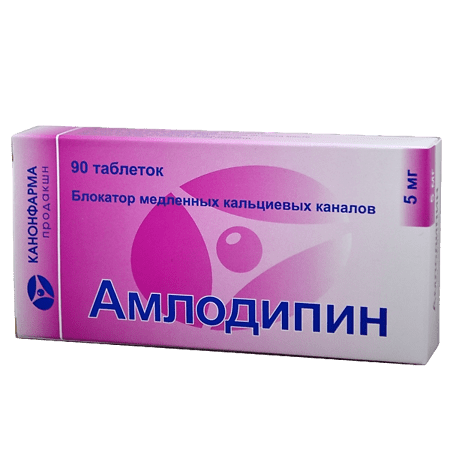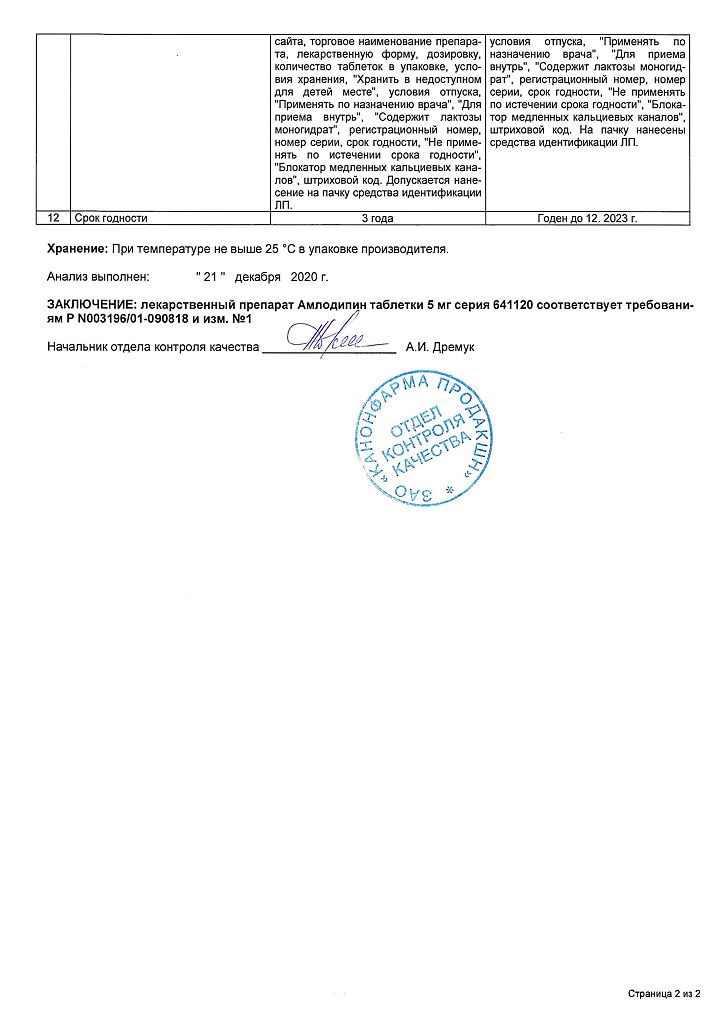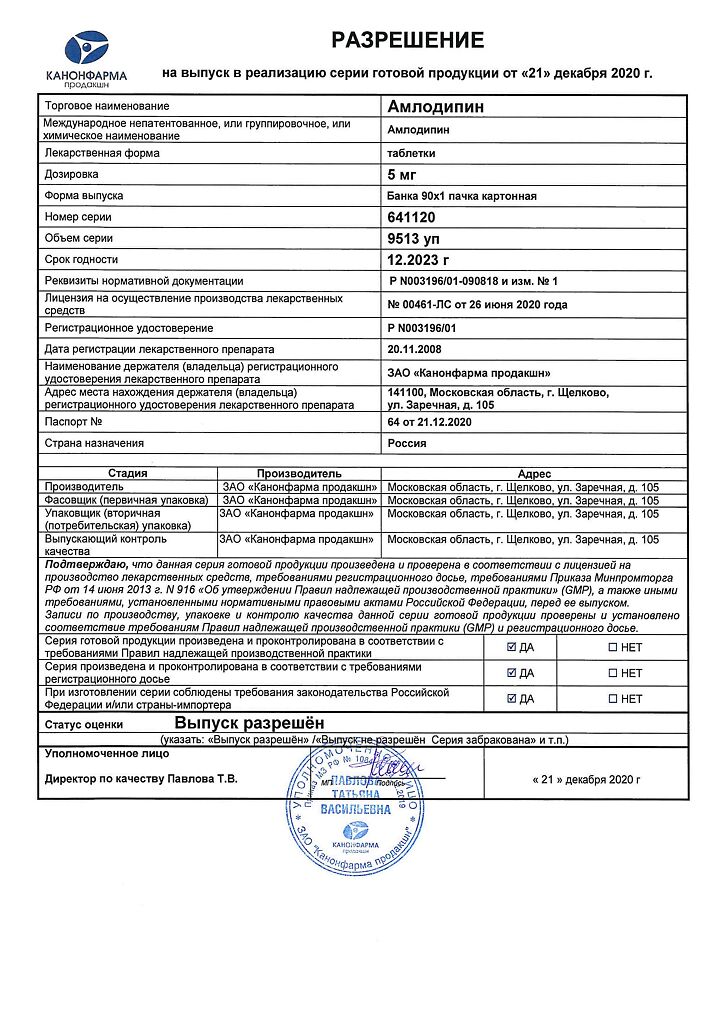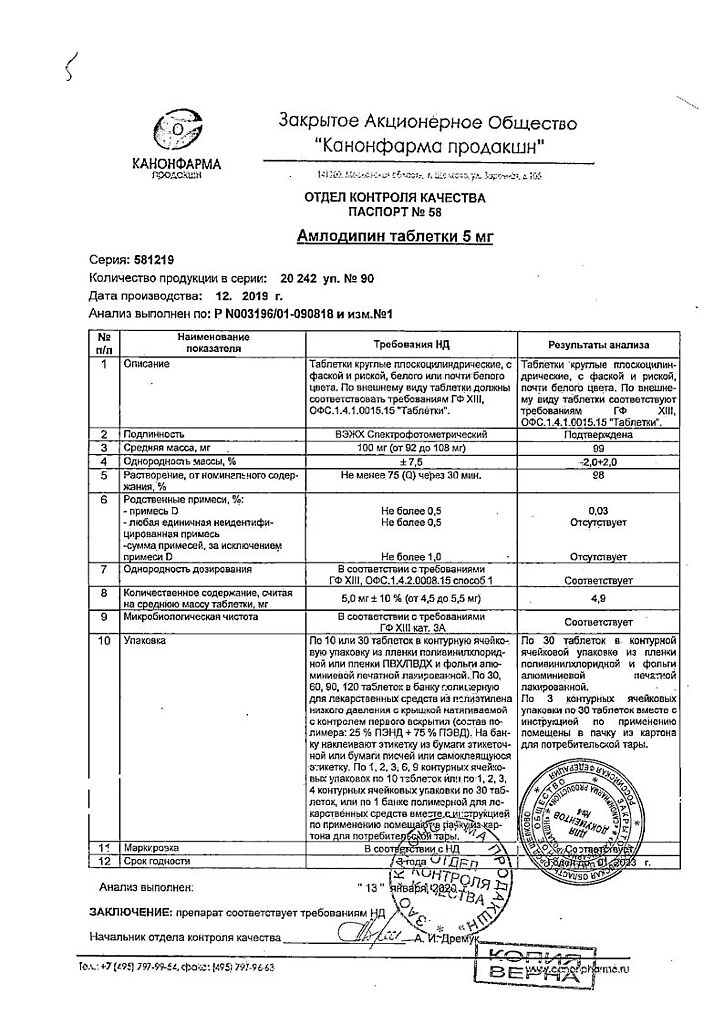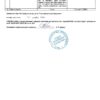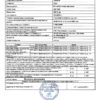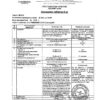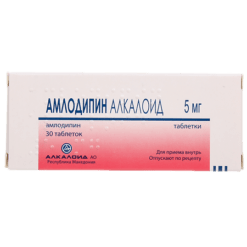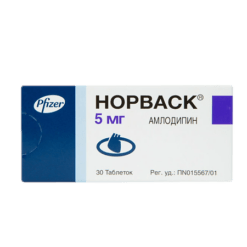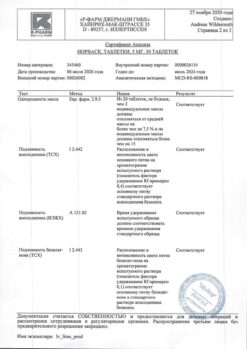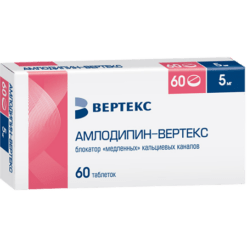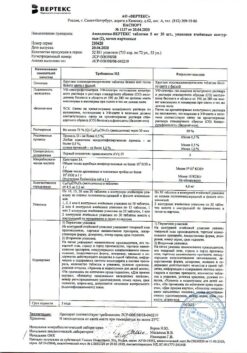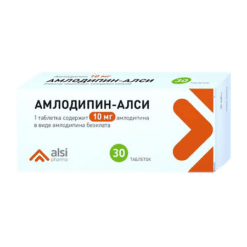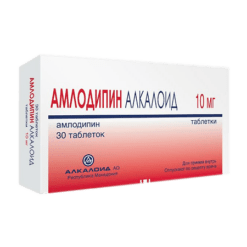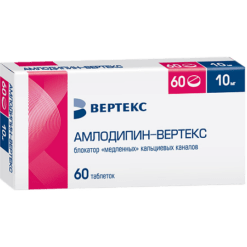No products in the cart.
Amlodipine, tablets 5 mg 90 pcs
€1.00
Out of stock
(E-mail when Stock is available)
Description
Pharmacodynamics
Amlodipine is a dihydropyridine derivative – “slow” calcium channels blocker (BMCC) of II generation, has antianginal and hypotensive effects.
Binding to dihydropyridine receptors it blocks calcium channels, decreases transmembrane transition of calcium ions into cell (more in vascular smooth muscle cells than in cardiomyocytes).
The antianginal action is due to the dilation of coronary and peripheral arteries and arterioles:
– in angina reduces the severity of myocardial ischemia; by dilating the peripheral arterioles, it reduces total peripheral vascular resistance; reduces the afterload on the heart, myocardial oxygen demand;
– Expands the main coronary arteries and arterioles in unchanged and ischemic areas of the myocardium, increases the flow of oxygen to the myocardium (especially in vasospastic angina); prevents the development of coronary artery spasm (including that caused by smoking).Also caused by smoking.)
In patients with stable angina a single daily dose increases exercise tolerance, delays the development of another angina attack and “ischemic” ST-segment depression; reduces the frequency of angina attacks and the consumption of nitroglycerin and other nitrates.
Amlodipine has a long-term dose-dependent hypotensive effect, which is due to a direct vasodilator effect on vascular smooth muscle. In arterial hypertension a single daily dose of amlodipine provides clinically significant reduction of arterial pressure (BP) for 24 hours (in “lying” and “standing” positions).
Orthostatic hypotension with amlodipine is rare. Amlodipine does not cause a decrease in exercise tolerance, left ventricular ejection fraction. It reduces the degree of left ventricular myocardial hypertrophy. It does not affect myocardial contractility and conduction, does not cause reflex increase in heart rate (HR), inhibits platelet aggregation, increases glomerular filtration rate, has a weak natriuretic effect.
In diabetic nephropathy it does not increase the severity of microalbuminuria. It has no adverse effect on metabolism and concentration of plasma lipids and can be used for treatment of patients with bronchial asthma, diabetes mellitus, and gout.
The time of onset of therapeutic effect is 2-4 hours, a significant decrease in BP is observed after 6-10 hours, the duration of effect is 24 hours.
In patients with cardiovascular diseases (including coronary atherosclerosis with lesions of one vessel and up to stenosis of 3 or more arteries, atherosclerosis of the carotid arteries) who have had a myocardial infarction, percutaneous transluminal coronary angioplasty (PTCA) or in patients with angina pectoris, the use of amlodipine prevents the development of carotid intima-media thickening, reduces mortality from myocardial infarction, stroke, PTCA, aortocoronary bypass; leads to fewer hospitalizations for unstable angina and progression of chronic heart failure (CHF); reduces the frequency of interventions to restore coronary blood flow.
The therapy with digoxin, diuretics and angiotensin-converting enzyme inhibitors (ACEI) does not increase mortality index or complication and lethal outcome in patients with CHF (NYHA functional class III-IV).
In patients with CHF (functional class III-IV according to NYHA classification) of non-ischemic etiology, the use of amlodipine may cause pulmonary edema.
Pharmacokinetics
Intake
After oral administration, amlodipine is slowly absorbed from the gastrointestinal tract. Food intake has no effect on absorption of amlodipine. The average absolute bioavailability is 64-80%. Maximum serum concentration is observed after 6-12 hours. Equilibrium concentration is reached after 7-8 days of therapy. Simultaneous intake of food has no effect on absorption of amlodipine.
Distribution
The average volume of distribution is 21 l/kg body weight, indicating that most of the drug is in the tissues and less in the blood. Most of the drug that is in the blood (97.5%) is bound to plasma proteins.
Metabolism
Amlodipine undergoes slow but active metabolism (90-97%) in the liver with no significant “first pass” effect.
Metabolites have no significant pharmacological activity.
The elimination half-life (T1/2) after single administration varies from 35 to 50 hours. When repeatedly administered, the T1/2 is approximately – 45 hours.
About 60% of a dose taken by mouth is excreted by kidneys mainly as metabolites, 10% – as unchanged, 20-25% – in bile and through intestine as metabolites.
The total clearance of amlodipine is 0.116 ml/kg (7 ml/min/kg,0.42 l/h/kg).
The use in elderly patients
The excretion of amlodipine is slower (T1/2 – 65 h) in elderly patients (over 65 years) compared to younger patients, but this difference has no clinical significance.
The use in patients with hepatic impairment
The prolongation of the T1/2 in patients with hepatic impairment suggests that with long-term use the cumulation of the drug in the body will be higher (T1/2 – up to 60 h).
The use in patients with renal impairment
Renal impairment has no significant effect on the kinetics of amlodipine. Amlodipine penetrates through the blood-brain barrier and is not eliminated by hemodialysis.
Indications
Indications
Artial hypertension (monotherapy or in combination with other antihypertensive agents);
Stable angina pectoris and vasospastic angina pectoris (Prinzmetal or variant angina pectoris, either in monotherapy or in combination with other antianginal agents).
Active ingredient
Active ingredient
Composition
Composition
1 tablet contains:
the active substance:
excipients:
calcium stearate 0.1 mg,
potato starch 19.43 mg,
silicon dioxide colloid 0.5 mg,
How to take, the dosage
How to take, the dosage
Overly, once daily with the required amount of water (100 ml).
In arterial hypertension, angina pectoris, the initial dose of amlodipine is usually 5 mg once daily. Depending on the therapeutic response, the daily dose may be increased to a maximum of 10 mg (once daily).
The use in elderly patients
Amlodipine is recommended in an average therapeutic dose; no dose adjustment is required.
The use in patients with impaired hepatic function
While the T1/2 of amlodipine, like all BMKs, is increased in patients with impaired hepatic function, no dose adjustment is usually required (see section “Special Precautions”).
The use in patients with impaired renal function.
The use of amlodipine in normal doses is recommended, but a possible slight increase in the T1/2 must be considered.
There is no need to change the dose when concomitantly prescribed with thiazide diuretics, beta-adrenoblockers and angiotensin-converting enzyme (ACE) inhibitors.
Interaction
Interaction
Microsomal oxidation inhibitors may increase the plasma concentration of amlodipine, increasing the risk of side effects, and hepatic microsomal enzyme inducers may decrease this parameter.
Unlike other DMARDs, amlodipine has no clinically significant interactions with nonsteroidal anti-inflammatory drugs, especially indomethacin.
Thiazide and “loop” diuretics, beta-adrenoblockers, verapamil, ACE inhibitors and nitrates enhance the antianginal or hypotensive effects of amlodipine.
Amiodarone, quinidine, alpha 1-adrenoblockers, antipsychotics (neuroleptics) and isoflurane may increase the hypotensive effects of amlodipine.
Calcium preparations may decrease the effect of BMCC.
The co-administration of amlodipine with lithium preparations may increase the neurotoxicity of the latter (nausea, vomiting, diarrhea, ataxia, tremor, tinnitus).
Amlodipine has no effect on the pharmacokinetic parameters of digoxin and warfarin.
Cimetidine has no effect on the pharmacokinetics of amlodipine.
The antiviral agents (ritonavir) contribute to increased plasma concentrations of PBMCs (including amlodipine).
Special Instructions
Special Instructions
Application in hepatic impairment: Patients with hepatic impairment as a hypotensive agent Amlodipine is prescribed with caution, in an initial dose of 2.5 mg, as an antianginal agent – 5mg.
Use in renal impairment:No dose changes are required in patients with renal impairment.
In elderly patients:The T 1/2 may be increased and creatinine clearance (CK) may be decreased. No dose changes are required, but closer monitoring of patients is necessary.
Dose changes are not required when concomitantly administered with thiazide diuretics, beta-adrenoblockers and angiotensin-converting enzyme (ACE) inhibitors.
Amlodipine treatment requires monitoring patients’ body weight and sodium salt intake; an appropriate low-salt diet is indicated. Dental hygiene should be maintained and regular visits to the dentist (to prevent soreness, bleeding and gum hyperplasia).
The dosing regimen of Amlodipine in elderly patients is similar to that in patients of other age groups. Careful monitoring of elderly patients is necessary when increasing the dose. Although there is no withdrawal syndrome in AMLs, a gradual dose reduction is recommended before discontinuing treatment.
Amlodipine does not affect plasma concentrations of potassium ions, glucose, triglycerides, total cholesterol, low-density lipoproteins, uric acid, creatinine and urea nitrogen. Abrupt withdrawal of the drug should be avoided because of the risk of worsening the course of angina pectoris. Amlodipine tablets are not recommended in hypertensive crisis.
Patients of low birth weight, short stature, and patients with significant liver dysfunction may require a lower dose.
Influence on driving and operating machinery
There have been no reports about the effect of Amlodipine on driving or operating machinery. However, drowsiness and Dizziness may occur in some patients, mainly at the beginning of treatment. If they occur, caution should be exercised when driving motor transport and engaging in potentially dangerous activities requiring high concentration and quick psychomotor reactions.
Contraindications
Contraindications
Hypersensitivity (including to other dihydropyridines), severe arterial hypotension (BP less than 90 mm Hg), pregnancy, lactation.
With caution. Arterial hypotension, aortic stenosis, CHD of non-ischemic aetiology (class III-IV according to NYHA), hepatic insufficiency, acute myocardial infarction (and during 1 month after), GFCI, CCS, age less than 18 years, elderly age.
Side effects
Side effects
WHO Classification of the incidence of side effects:
very often – â¥1/10;
often – â¥1/100 to < 1/10;
infrequent – â¥1/1000 to < 1/100;
rarely – â¥1/10000 to < 1/1000;
very rarely, < 1/10000, including individual reports;
frequency unknown – it is not possible to determine the frequency of occurrence from the available data.
Cardiovascular system side:
often – palpitations, peripheral edema (swelling of ankles and feet), flushes of blood to the skin of the face;
infrequently – excessive decrease in BP;
Very rare – syncope, dyspnea, vasculitis, orthostatic hypotension, development or worsening of chronic heart failure, heart rhythm disorders (including bradycardia, ventricular tachycardia, atrial fibrillation), myocardial infarction, chest pain.
Musculoskeletal system disorders:
seldom – arthralgia, muscle cramps, arthrosis, myalgia (with long-term use), back pain;
Rarely – myasthenia gravis.
The central nervous system:
often – headache, dizziness, increased fatigue;
infrequently – general malaise, fainting, asthenia, hypoesthesia, paresthesias,
peripheral neuropathy, tremor, insomnia, emotional lability, unusual dreams, increased agitation, depression, anxiety, tinnitus, perversion of taste;
very rarely – migraine, increased sweating, apathy, agitation, ataxia, amnesia;
frequency unknown – extrapyramidal disorders.
Digestive system disorders:
frequently – nausea, abdominal pain;
infrequently – vomiting, constipation or diarrhea, flatulence, dyspepsia, anorexia, dry oral mucosa, thirst;
rare – gum hyperplasia, increased appetite;
very rare – gastritis, pancreatitis, hyperbilirubinemia, jaundice (usually cholestatic), increased activity of liver transaminases, hepatitis.
The hematopoietic organs:
very rare – thrombocytopenia, leukopenia, thrombocytopenic purpura.
Respiratory system disorders:
infrequent – shortness of breath, rhinitis, nasal bleeding;
very rare – cough.
Senses:
infrequent – diplopia, accommodation disorder, xerophthalmia, conjunctivitis, eye pain, visual disturbances.
Urogenital system disorders:
infrequent – frequent urination, painful urination, nycturia, impaired erectile function;
very rare – dysuria, polyuria.
Skin disorders:
rarely – dermatitis;
very rarely – cold sweat, xeroderma, alopecia, impaired skin pigmentation.
Allergic reactions:
infrequent – skin itching, rash (including erythematous, maculopapular rash, urticaria);
very rare – angioedema, erythema multiforme.
Laboratory indices:
very rarely – hyperglycemia.
Other:
infrequent – chills, gynecomastia, pain of unspecified localization, alopecia; very rare – parosmia.
Overdose
Overdose
Symptoms:A marked decrease in BP with possible development of reflex tachycardia and excessive peripheral vasodilation (risk of severe and persistent arterial hypotension, including development of shock and death).
Treatment:Gastric lavage, administration of activated charcoal (especially in the first 2 hours after overdose), maintenance of cardiovascular function, control of heart and lung function parameters, Trendelenburg posture, control of circulating blood volume and diuresis. To restore vascular tone – use vasoconstrictors (if there are no contraindications for their use); to eliminate the effects of calcium channel blockade – intravenous injection of calcium gluconate. Hemodialysis is not effective.
Pregnancy use
Pregnancy use
The safety of Amlodipine during pregnancy has not been established; therefore, use during pregnancy is possible only when the benefit to the mother exceeds the risk to the fetus and the newborn.
There is no evidence that amlodipine is excreted into breast milk. However, other dihydropyridine derivatives are known to be excreted in breast milk. Therefore, if Amlodipine should be used during lactation, it is necessary to consider stopping breastfeeding.
There was no effect of amlodipine on fertility in a study in rats.
Similarities
Similarities
Additional information
| Shelf life | 3 years. |
|---|---|
| Conditions of storage | Store in a dry, light-protected place at a temperature not exceeding 25 ° C. |
| Manufacturer | Kanonfarma Production ZAO, Russia |
| Medication form | pills |
| Brand | Kanonfarma Production ZAO |
Other forms…
Related products
Buy Amlodipine, tablets 5 mg 90 pcs with delivery to USA, UK, Europe and over 120 other countries.

